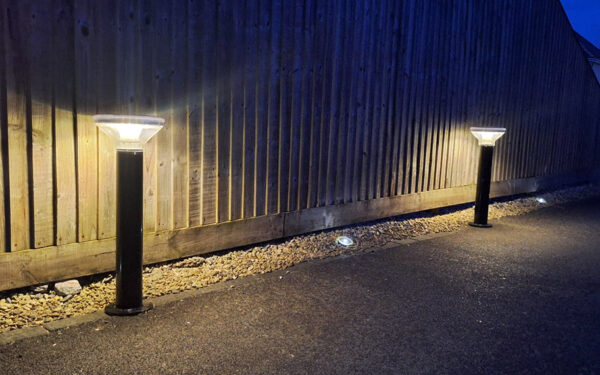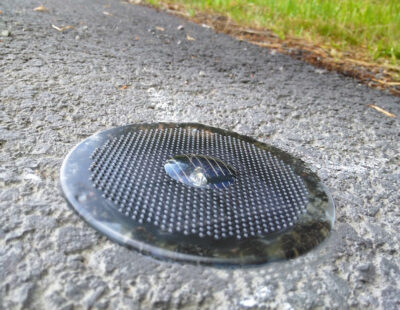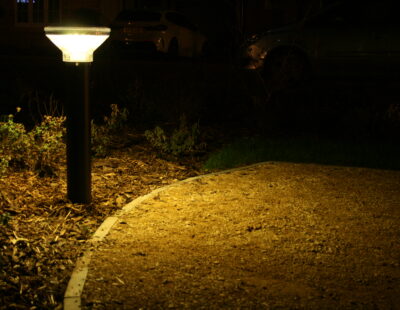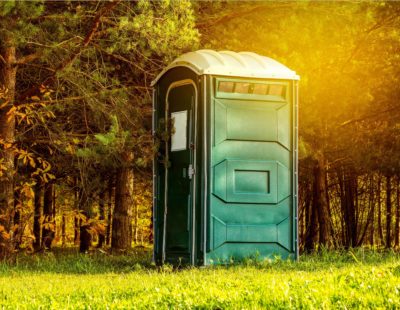We’re often asked whether our solar lights are impacted by the weather or shorter daylight hours over the winter months. The simple answer is yes, solar lights can work when it’s cloudy or during the winter, but their performance may be affected.
At Solareye, we offer a range of solar lights from our Solareye80 ground light which is often used to delineate cycle paths and pedestrian walkways, to our Solareye Bollard Light which provides greater illumination to safely guide people around outside spaces at night. All Solareye products have been designed to optimise charging in Northern European Weather conditions and do not need direct sunlight to work.
Read on for more information about how solar lights work, how charging is affected by reduced sunlight and how we designed our range of solar lights to optimise charging in winter or on cloudy days.
How do solar lights work?
Solar lights operate by converting sunlight into electrical energy, which is then stored in batteries for use when it’s dark.
Each solar light is equipped with a solar panel, also known as a photovoltaic (PV) panel. This panel captures sunlight and converts it into electricity. The efficiency of this conversion depends on the quality and size of the solar panel, as well as the intensity of the sunlight.
The electricity generated by the solar panel is stored in a rechargeable battery. This storage allows the light to be powered during the night or on cloudy days when sunlight isn’t available. The capacity of the battery determines how long the light can operate on the stored energy.
A component called a charge controller is crucial for protecting the battery from being overcharged by the solar panel during sunny days or from being over-discharged during usage. It ensures the longevity and efficiency of the battery.
Solar lights typically use LED (Light Emitting Diode) bulbs because they are energy-efficient, have a long lifespan, and require minimal power to illuminate. The stored electricity in the battery powers these LEDs.
Most solar lights come with an inbuilt light sensor that automatically turns the light on at dusk and off at dawn. This sensor detects the level of surrounding light and controls the lighting based on the time of day, which conserves the stored energy in the battery for when it’s needed.
In summary, during the day, the solar panel charges the battery. When it becomes dark, the light sensor triggers the LED light to turn on, powered by the electricity stored in the battery. This cycle repeats daily, allowing for a sustainable and environmentally friendly lighting solution.
Do solar lights need direct sunlight?
On cloudy days or in winter, when daylight hours are shorter and the sun’s position is lower in the sky, solar panels receive less sunlight, leading to reduced energy production. However, most solar lights are designed to account for these conditions in several ways:
- – Efficient Solar Panels: Modern solar lights use highly efficient photovoltaic cells that can convert even indirect or diffused sunlight (like on cloudy days) into electricity, albeit at a lower rate compared to direct sunlight.
- – Energy Storage: Solar lights store energy in batteries during the day, which allows them to operate at night. The capacity of these batteries can affect how long the lights will run. On days with less sunlight, the lights might not charge fully, resulting in shorter illumination times.
- – LED Technology: Solar lights typically use LED bulbs because they are more energy-efficient and have a lower power requirement than traditional bulbs. This means they can still provide light even when the battery isn’t fully charged.
Ever wondered whether you should clean your solar lights? Find out with our blog post >
How are Solareye lights designed to optimise charging in winter or on cloudy days?
High-capacity batteries
Our solar lights are designed to illuminate throughout the night on the longest night in winter (21st December) with Northern European weather conditions in mind. To achieve this Solareye80 ground lights, Solareye roof light and Solareye Bollard light have high-capacity long-life lithium iron phosphate batteries to store energy generated in the summer months, when sunlight is plentiful, for use in the winter when the battery is unlikely to receive a full charge, whether that’s due to cloud or fewer daylight hours.
Solareye80 ground lights will illuminate for 200 hours from a full charge, but because the inbuilt light sensor activates the light only when it is dark, it will only ever be illuminated for a maximum of 16 hours (on the longest night). This means that there will be plentiful charge left in the battery which will be topped up as the battery charges during the day.
Anti-skid dimples
Another design feature that optimises the Solareye80 ground lights’ charging capabilities are the anti-skid dimples. As well as making the surface of the ground lights safe for bicycle wheels to pass over, they also serve to capture more sunlight which in turn makes charging more efficient.
Motion activated illumination
There are several design features which help to optimise charging for Solareye Bollard Light. In addition to the high-capacity battery, Solareye Bollard Light can be programmed to idle at 50% illumination and increase to 100% when the inbuilt motion sensor detects a path user approaching. By idling at 50% the available charge in the battery is optimised and full illumination only takes place when it is necessary (i.e. someone uses the path).
Learn more about how motion sensors in solar lights work >
Solareye Roof Light is also programmed to optimise charging by only illuminating when it’s required. The high-capacity battery is sufficient to provide 18 hours of consecutive illumination, however Roof Light is programmed to switch off every 45 seconds, unless motion is detected. This means that from a full charge Solareye Roof Light will illuminate more than 1,500 times – far more than is necessary for your average portable toilet use.
Learn more about solar lighting for portable toilets >
Other ways to optimise the performance of your solar lights
To optimise performance during cloudy days or in winter, it’s important to place solar lights in areas where they can receive the maximum possible sunlight throughout the day and ensure that the solar panels are clean and free from obstruction.
Learn more about how to install Solareye80 ground lights >
Solar lights from Solareye
For solar lights that you can trust to illuminate even on the longest, cloudiest, winter nights, choose Solareye. Our lights are low-maintenance, economic to run and perfect for off-grid locations as well as gardens and residential settings.
Get in touch with our friendly team to discuss your requirements.





